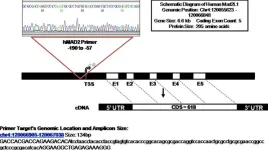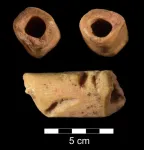(Press-News.org) New research on rural New Englanders shows that gardening, hunting, fishing and other HWFP activities are important tools for maintaining food security through extreme events, such as pandemics or climate change events.
University of Vermont and University of Maine researchers found that both food insecurity and home and wild food production (HWFP) – gardening, hunting, fishing, foraging, and having “backyard” poultry or livestock – increased significantly during the COVID-19 pandemic, and those who undertook HWFP activities exhibited improved food security 9-12 months later.
The paper, published in Scientific Reports, surveyed over 1,000 individuals in rural Vermont and Maine (the two most rural states in the country) to identify their food security and food sources.
Researchers hope that policymakers will consider how HWFP might lead to a more resilient food system. “Home and wild food production is not a silver bullet, but it is a potential solution set that has been largely overlooked,” said Meredith Niles, Associate Professor at the University of Vermont, who led the study.
Programs that support HFWP are often overlooked by policymakers, but the research suggests that these activities could bolster food security, especially during ever more frequent crisis situations.
“Even during normal times, there are many barriers to food access especially for people experiencing poverty. When the COVID-19 pandemic began, there were additional barriers including travel restrictions, stay at home orders, and disruptions to the supply chain,” said Rachel Schattman, Assistant Professor of Sustainable Agriculture at the University of Maine. “While there were a variety of food assistance programs, no one had really looked at how self-provisioning things like hunting, gardening, canning, foraging and raising backyard animals contributed to food security.”
There was anecdotal evidence in the early days of the pandemic about people starting gardens and stories about canning jar shortages, but Niles says this paper brings quantitative data to back up those stories. “We were able to actually show, at a large scale with significant data, that people who did home and wild food production, especially gardening, in the early part of the pandemic, were more likely to be food secure 9 to 12 months later,” said Niles. “It’s exciting because we haven’t really seen this scale of data before and over multiple time points to assess this issue.”
“We’ve suspected that producing some of your own food through hunting, fishing, foraging, gardening helps people’s food security. This is the best evidence yet that we have that producing your own food makes a difference,” said Sam Bliss, postdoctoral fellow at the University of Vermont who was involved in the research.
One key takeaway from this report was that individuals who were newly food insecure during the pandemic seemed to be the best at recovering from food insecurity with home and wild food production, as compared to those food insecure also before the pandemic. “Our team is really interested to understand why chronically food insecure people in particular don’t seem to be able to use home and wild food production in the same way to improve food security as other people,” said Niles. “We have some information on the barriers they face and are exploring other work to assess how to overcome these issues.”
“We need policies and programs that make producing your own food more accessible to the people who could stand to benefit the most from it,” said Bliss.
The UVM research team included Meredith T. Niles, Ashley C. McCarthy, Sam Bliss, Emily H. Belarmino, Scott C. Merrill, Sarah A. Nowak, Jennifer Laurent, Farryl Bertmann, Rebecca Mitchell working with Rachel E. Schattman, Jonathan Malacarne, and Kate Yerxa (University of Maine). This project was supported by the UVM College of Agriculture and Life Sciences, the Food Systems Research Center, and the Gund Institute for Environment. This project was a collaboration leading from The National Food Access and COVID Research Team (NFACT).
END
In rural states, gardening and foraging helped prevent hunger during COVID: Study
2024-02-13
ELSE PRESS RELEASES FROM THIS DATE:
New study finds roughly 1 in 10 pregnant people will develop long COVID
2024-02-13
UNDER EMBARGO UNTIL: Feb. 12, 2024 5:45 p.m. Eastern Standard Time
Media Contacts: Karen Addis, APR, karen@addispr.com, +1 (301) 787-2394; Kerri Wade, MPA, kwade@smfm.org, +1 ...
Differential expression of Mad2 gene in human esophageal cancer
2024-02-12
“[...] people of the northeastern region [of India] consume betel quid, consisting of raw areca nut [...]. People often swallow the entire betel-quid after chewing, which is believed to contribute to the development of oral, esophageal, and gastric cancers.”
BUFFALO, NY- February 12, 2024 – A new research paper was published in Oncotarget's Volume 15 on February 5, 2024, entitled, “Differential expression of Mad2 gene is consequential to the patterns of histone H3 post-translational modifications in its promoter region in human esophageal ...
RIT's Center for Detectors to work on two NASA projects
2024-02-12
Rochester Institute of Technology’s Center for Detectors has been chosen by NASA for two research programs: Early Stage Innovations (ESI) and Strategic Astrophysics Technology (SAT), with the hope of helping future spacecraft find new discoveries in the vast universe.
Under the leadership of Center for Detectors Director Don Figer, the team will be advancing and characterizing single-photon sensing complementary metal-oxide semiconductor (CMOS) image sensors to determine if they can survive the harsh radiation environments in NASA missions. The intent is to fly these types of detectors on future missions to find life on Jupiter’s ...
Archaeologists discover oldest known bead in the Americas
2024-02-12
University of Wyoming archaeology Professor Todd Surovell and his team of collaborators have discovered a tube-shaped bead made of bone that is about 12,940 years old.
The bead, found at the La Prele Mammoth site in Converse County, is the oldest known bead in the Americas.
Surovell’s research was published in the peer-reviewed journal Scientific Reports; the paper is titled “Use of hare bone for the manufacture of a Clovis bead.” Members of the research team included people from UW, the Office of the Wyoming State Archaeologist, the University of Manchester, Weber ...
Interferon-gamma drives brain pathology in a mouse model of multiple system atrophy
2024-02-12
BIRMINGHAM, Ala. – Multiple system atrophy is a rare and fatal neurodegenerative disease, where insoluble inclusions of the protein alpha-synuclein appear in oligodendrocyte cells of the brain. The resulting pathogenesis features neuroinflammation, demyelination and neurodegeneration. Oligodendrocytes produce myelin, an insulating sheath on the axons of nerves.
In 2020, Ashley Harms, Ph.D., and University of Alabama at Birmingham colleagues published an Acta Neuropathologica study that used a mouse model to show that the ...
Drought may drive deadly amphibian disease, researchers find
2024-02-12
UNIVERSITY PARK, Pa. — Pumpkin toadlets are in trouble. Progressively severe droughts are disrupting the microbiomes of the thumbnail-sized orange frogs, potentially leaving them vulnerable to a deadly fungal disease, according to a new study by an international research team. The finding suggests that abnormal rainfall patterns, which are expected to worsen due to climate change and deforestation, may upset mutually beneficial relationships between wildlife and microorganisms, leading to biodiversity decline.
The researchers, led by Penn State doctoral ...
New study finds commonly used antibiotic is a cost-saving treatment for reducing maternal sepsis, death or infection in developing countries
2024-02-12
UNDER EMBARGO UNTIL: Feb. 12, 2024, 4:30 PM EST
Media Contacts: Karen Addis, APR, karen@addispr.com, +1 (301) 787-2394; Kerri Wade, MPA, kwade@smfm.org, +1 (202) 236-1780
National ...
Reshaping our understanding of granular systems
2024-02-12
Your morning cereal, a jar of nuts, the sands of distant planets, and even the concrete in your city are all examples of granular systems surrounding us. And such systems are harboring secrets that could change the way we mix things up.
In a new paper published in the journal Proceedings of the National Academy of Sciences (PNAS), scientists at the University of Rochester, including Rachel Glade, an assistant professor of earth and environmental sciences and of mechanical engineering; Fernando David Cúñez, a former postdoctoral research associate ...
Can hydrogels help mend a broken heart?
2024-02-12
You can mend a broken heart this valentine’s day now that researchers invented a new hydrogel that can be used to heal damaged heart tissue and improve cancer treatments.
University of Waterloo chemical engineering researcher Dr. Elisabeth Prince teamed up with researchers from the University of Toronto and Duke University to design the synthetic material made using cellulose nanocrystals, which are derived from wood pulp. The material is engineered to replicate the fibrous nanostructures and properties of human tissues, thereby recreating its unique biomechanical properties.
"Cancer is a diverse disease and two patients with the same type of cancer will often respond ...
New study finds that pregnancy complications can also affect child’s health later in life
2024-02-12
Hypertensive disorders of pregnancy (HDP) and gestational diabetes (GDM) are two of the most common pregnancy complications and put pregnant people at increased risk of developing cardiovascular disease later in life.
Now, in a new study to be presented today at the Society for Maternal-Fetal Medicine’s (SMFM) annual meeting, The Pregnancy Meeting™, researchers will unveil findings that suggest these pregnancy complications may also result in worse cardiovascular health for the child.
In a secondary analysis of 3,317 maternal-child pairings from the prospective Hyperglycemia ...




